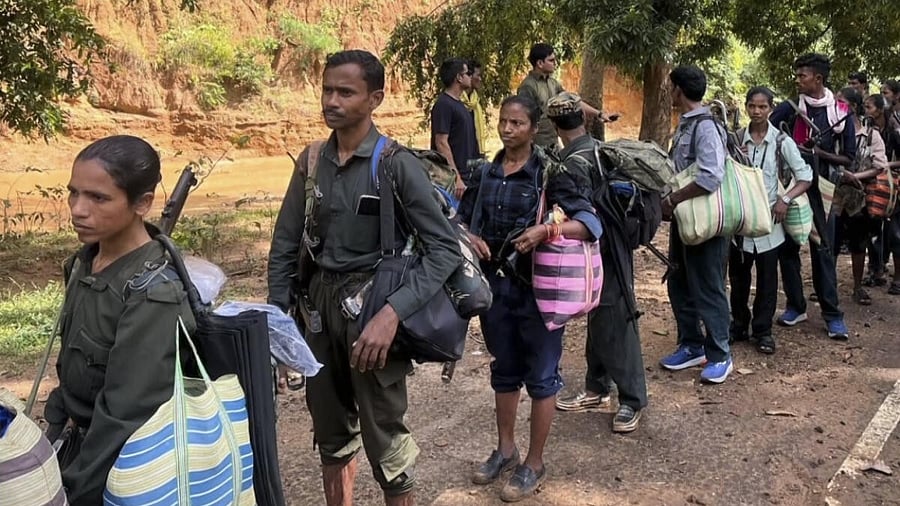
Representative image of Maoist cadres surrender with weapons before the authorities.
Credit: PTI
Hyderabad: Over the past year, alongside Chhattisgarh, security forces have achieved near-total success in eliminating top Naxal leaders from the Andhra–Odisha Border (AOB), long regarded as a safe sanctuary for the ultras. The killings of Hidma and Tech Sankar are viewed by Andhra security forces as a tipping point in this sustained campaign.
In May 2025, during an exchange of fire in the forested terrain between Y. Ramavaram and Addateegala in Alluri Sitarama Raju (ASR) district, police teams killed Kakuri Pandanna alias Jagan—a key member of the Andhra–Odisha Border Special Zonal Committee (AOBSZC)—along with another senior operative. The encounter dealt a major blow to Maoist consolidation efforts along the AOB axis. A month later, another gun battle in the Devipatnam forest area led to the deaths of Central Committee Member Gajarla Ravi alias Uday and senior woman leader Aruna of the AOB Special Zonal Committee.
Uday, widely regarded as the last active Central Committee-level commander operating in the AOB region, had played a pivotal role in Maoist strategy and coordination. His death, alongside Aruna’s, effectively dismantled the last remaining political and operational anchors of the AOB structure.
“Through these operations, Uday, Aruna, Jagan and Divisional Committee Secretary Ramesh were among six Maoists killed in five encounters over the past year, underscoring the leadership-focused, intelligence-driven strategy employed by the Andhra Pradesh Police. Hidma, long seen as the operational architect of major attacks across Dandakaranya, was eliminated in one of the most significant blows to Maoist capability in over a decade,” said a senior Andhra Pradesh police official.
Taken together, the killing of Uday, Jagan, Aruna, Hidma and their close associates marks a watershed in the state’s decades-long fight against Maoism. These coordinated, intelligence-led operations led to the collapse of both the AOB’s political–organisational framework and the South Bastar operational command, scattering surviving cadres and triggering mass movement from Chhattisgarh into Andhra Pradesh, where most were later apprehended.
In an extensive operation conducted by Andhra Pradesh’s anti-Naxal wing on Tuesday and Wednesday, around 50 Maoist operatives were captured, and a massive cache of arms was seized. The operation also led to the arrest of several high-value Divisional Committee Members (DVCMs) , a crucial operational tier within the CPI (Maoist) hierarchy, responsible for armed actions, recruitment, logistics, IED deployment and cross-border coordination.
Those apprehended include Sodi Lakma alias Bhima, DVCM of the Jagargonda Area Committee and key coordinator of armed squads across the Sukma–Jagargonda axis; Gangi Lakshmi alias Maade, DVCM under Kerlapal AC of the Dharba Division, known for managing support routes; Sode Manila, DVCM and in-charge of Pamed AC, SBT DVC and the Dandakaranya Special Zonal Committee (DKSZC) one of the most strategically vital posts in the South Bastar theatre; and Madavi Handha, DVCM from the Communication and CyPC Team of SBT DVC, responsible for secure messaging and operational coordination within the battalion framework.
Collectively, these DVCMs represent the core of the Maoist divisional command network. Their simultaneous arrest cripples multiple Area Committees, severs inter-district linkages, and delivers one of the most debilitating organisational setbacks to the CPI (Maoist) in the Dandakaranya region in recent years.